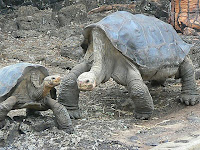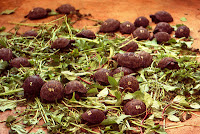 |
| Entrace to CDRS by Scott Abelman |
 |
| George and a Female |
Though George was a symbol and icon of conservation not only of the giant tortoises, but of all of the environmental sustainability throughout the Galapagos Islands, and he is missed, I want to make it absolutely clear that though he was the most famous, George is certainly not the only important reason for a visit to the CDRS. In fact, under the rules of the Galapagos National Park Service, every touring Galapagos Island guest must visit either the CDRS or the Galapagos Interpretation Center on San Cristobal Island. The reason the CDRS is a “must see” attraction becomes obvious the moment you enter.
The CDRS is part of the Charles Darwin Foundation which states that its “mission is to provide knowledge and assistance through scientific research and complementary action to ensure the conservation of the environment and biodiversity in the Galapagos Archipelago.” Within this context, CDF's vision is “to be the world's leading research institution dedicated to the conservation of the biological diversity and natural resources of Galapagos, and committed to building a sustainable and collaborative society to achieve this objective.” One might call the CDRS the epicenter of sustainability and conservancy for the entire Galapagos Islands.
 Though you won't be seeing George - known for his longevity and solitary status - you will see Diego. And, really, Diego has a lot going for him as he is the future of revival of the Galapagos Islands' tortoises population. With George gone, Diego is in the spotlight – as well he should be.
He has fathered at least 2000 babies - almost every little hatchling that you will see at the CDRS. Where George never
successfully mated (or for that matter, even tried), Diego is prolific and still going strong.
Though you won't be seeing George - known for his longevity and solitary status - you will see Diego. And, really, Diego has a lot going for him as he is the future of revival of the Galapagos Islands' tortoises population. With George gone, Diego is in the spotlight – as well he should be.
He has fathered at least 2000 babies - almost every little hatchling that you will see at the CDRS. Where George never
successfully mated (or for that matter, even tried), Diego is prolific and still going strong. Diego is distinguished by his broken shell - a minor flaw insofar as the female tortoise population is concerned. The interesting story is how he got the broken shell. One of the many ways in which the CDRS staff tried to encourage George to mate was to allow Diego into his pen with some of the females, hopefully to show Lonesome George how to "do it." Well, George - though still not at all interested in engaging with the opposite sex - got what appeared to be the tortoise equivalent of jealous of Diego's antics and pushed him over, resulting in the broken shell. It seems to make Diego all the more handsome to his many willing mates!
A visit to the tortoise preserve and nursery is an eye-opening experience to say the least. Its scope, the number of species being studied and protected, the dedication to the little hatchlings and the purpose of returning them to their native habitats all attest to the commitment of the CDRS to its mission. The Galapagos Tortoise is found throughout the archipelago and different species populate each island. In many respects, the tortoises stand as the symbol of Darwin’s theory of adaptation to the environment.
 |
| Hatchlings |
 |
| Hatchling |
 |
| Land Iguana |
 |
| Attempted Escape |
Another very important project undertaken at the CDRS is preservation and restoration of the land iguana population on Santa Cruz, Baltra and Isabela Islands. You will see examples of each of these species on your visit.
All photos from Flickr Creative Commons unless otherwise noted.



My husband and I enjoyed our trip to the Galapagos Islands this January. We loved the Reasearch Center along with the many islands we visited. In fact this trip has become one of the top 4 trips we have taken over the last 30 years!
ReplyDeleteDon't miss! And make sure you have a great guide!! Harry Jimenez was ours and he is definitely in that category!
Kayakers who want to add to their sea also check out Snorkeling vancouver kayaking adventures and explorations will find many destinations to choose from in sea kayaking guide books. Here are a few of the those available
ReplyDelete